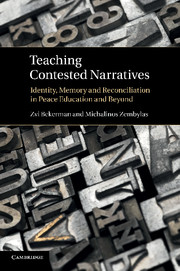Book contents
- Frontmatter
- Contents
- Acknowledgments
- Permissions
- Part I Introduction and theoretical underpinnings
- Part II Living and teaching contested narratives
- 4 Victims and perpetrators
- 5 (Im)possible openings
- 6 The everyday challenges of teaching children from conflicting groups
- 7 The emotional complexities of teaching contested narratives
- Part III Mourning, forgiveness and reconciliation
- Part IV Conclusions
- References
- Index
5 - (Im)possible openings
Published online by Cambridge University Press: 05 December 2011
- Frontmatter
- Contents
- Acknowledgments
- Permissions
- Part I Introduction and theoretical underpinnings
- Part II Living and teaching contested narratives
- 4 Victims and perpetrators
- 5 (Im)possible openings
- 6 The everyday challenges of teaching children from conflicting groups
- 7 The emotional complexities of teaching contested narratives
- Part III Mourning, forgiveness and reconciliation
- Part IV Conclusions
- References
- Index
Summary
Continuing from the previous chapter, here we describe and analyze the difficulties the teachers participating in our workshop experienced in overcoming their need to uphold a strong sense of identification with the history of their own communities, even when they are provided with clearer alternatives to hegemonic narratives. The results are not so encouraging in relation to the potential of educators to help overcome situations of intractable conflict, even within contexts specifically devised to encourage dialogue, as are the bilingual integrated Jewish-Palestinian schools in which these teachers develop their professional lives. Yet, our concern here is to find possible openings that may disrupt hegemonic narratives despite the immense challenges that exist.
The task of disrupting hegemonic narratives is so challenging because teachers, like other adults, often invest strong emotions in particular historical narratives and ideologies with which they identify (Boler and Zembylas, 2003; Zembylas, 2007). Therefore, there are two stories we want to tell in this chapter: on one hand, the pessimistic story is that teachers will not change their identifications with hegemonic narratives unless radical structural transformations take place – that is, social, political and educational transformations that somehow undermine the power of hegemonic narratives; on the other hand, the optimistic story is that an ongoing agonistics of raising critical issues regarding one's identifications with hegemonic narratives does offer openings to take responsibility for both the challenges and the dialogic possibilities that are created in the process. In this chapter we tell both stories, showing how they are especially captivating to those working to develop history curricula that address multiple perspectives, particularly the perspectives of those engaged in conflict. We are especially interested in highlighting two possible openings in this effort: first, the importance of contextualizing conflicts in the wider social and political arenas and the investigation of the seemingly insurmountable contextual forces which might impede efforts for peaceful coexistence and reconciliation both in society and schools; and, second, the value of developing empathy through the exchange of (also forgotten) memories, without abandoning asymmetries (e.g., asymmetries in terms of the trauma experienced by conflicting communities), while being open to possible symmetries (e.g., symmetries on the basis of common human suffering). The latter opening – the only one that is realized in our workshops – provides a useful point of departure for establishing common ground; the former opening – which unfortunately has not materialized in our workshops, despite the attempts to encourage its use – shows that challenging contested narratives has to move beyond a superficial level.
- Type
- Chapter
- Information
- Teaching Contested NarrativesIdentity, Memory and Reconciliation in Peace Education and Beyond, pp. 86 - 99Publisher: Cambridge University PressPrint publication year: 2011



